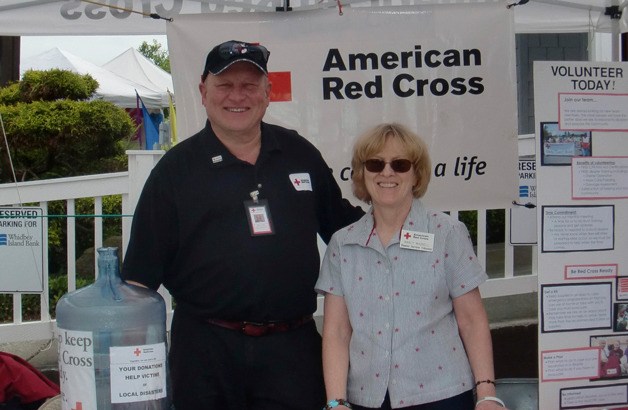For Whidbey Island Red Cross volunteers, it’s not a question of “if,” it’s a question of “when” a disaster will occur.
Staying prepared is a top priority.
Most recently, seven volunteers from the Islands Chapter of the American Red Cross helped staff an emergency shelter in Everett that opened Dec. 15. A large apartment fire in downtown Everett that day took one person’s life and left 20 others in need of temporary housing. An additional volunteer provided all the financial tracking for the shelter from his Friday Harbor office.
Snohomish County Red Cross volunteers opened the shelter at Central Lutheran Church in Everett, and staffed it around the clock with help from other chapters in the region. Volunteers serve as shelter operators, cooks, caseworkers and case managers, nurses and mental health counselors.
“We were happy to help out,” said Ron Conlin, disaster services coordinator for Islands Chapter. “Snohomish County volunteers had responded to 12 incidents in 12 days, and they needed relief. We were able to send people from South and North Whidbey and the San Juans.”
While responding to fires and other minor disasters are routine for the Red Cross, the face of the organization is changing as they learn through hard experience, namely, Hurricane Katrina.
“That was the first time the Red Cross has operated in disaster mode for that long … more than a year,” Conlin said. “There were lessons learned from Katrina and everything that went wrong. There were things we never expected to deal with — like sheltering for pets. People died because they wouldn’t abandon their pets.”
As a result of those hard lessons learned, Conlin said the Red Cross went into Hurricane Sandy in “a ramped up space” that was more prepared.
In addition to providing much needed short-term shelter and food to disaster victims, the Red Cross also service first responders, providing food and water during fires or floods. Out of 131 volunteers that comprise the Islands Chapter, roughly 50 reside on Whidbey Island. Others live in the San Juans or on Fidalgo Island.
This includes 21 licensed registered nurses and psychologists who are ready to help with medical and mental health needs.
Unlike other chapters around Washington and the country, the Islands Chapter faces some unusual obstacles.
“Our chapter is unique and geographically challenging due to the mix of land and water,” Conlin said. “It’s important for us to be training our people and the general population.”
The group faced a rash of pre-Christmas fires, which is relatively standard given the increased use of lights and space heaters. The chapter had 30 disaster calls for the month of December.
Conlin said last year was pretty hard on Islands Red Cross but that was partially because they are gaining a higher profile in the area, working with more local fire departments to be on their first call list.
In addition, Whidbey volunteers have deployed all over the country for emergency assistance, including Hurricane Sandy on the East Coast and flooding in Colorado.
The Red Cross mainly focuses on immediate short term aid and works with other agencies, such as Catholic Charities for longer term needs.
“The Red Cross is a crucial player in emergency response and preparedness in our diverse group of island communities,” said Mike Stamper, executive director of Islands chapter.
In addition, the area chapters have unveiled a new program with Puget Sound Energy entitled “Safe in the Sound,” which aims to prepare at-risk areas for earthquakes and tsunamis, teaching residents basic first aid and how to “shelter in place,” Conlin said.
Safe in the Sound work to keep individuals and communities throughout the Puget Sound region and coastal communities build their capacity to withstand, quickly adapt to and successfully recover from disasters, Conlin said.
In recent years, catastrophic earthquakes have killed hundreds of thousands of people and caused billions of dollars in damage worldwide, according to data from the Red Cross. In 2011, 14.9 million people around the world were displaced due to natural disasters. The 2011 Japanese earthquake and tsunami serve as powerful reminders of the need for individuals, neighborhoods and businesses to prepare.
The state of Washington is second only to California in risk of infrastructure damage and economic loss due to earthquakes. Furthermore, the Seattle, Tacoma and Bellevue area ranks fifth among cities nationwide in terms of risk of infrastructure damage and economic risk due to earthquakes.
For more information or to volunteer visit, www.safeinthesound.org or www.redcross.org



